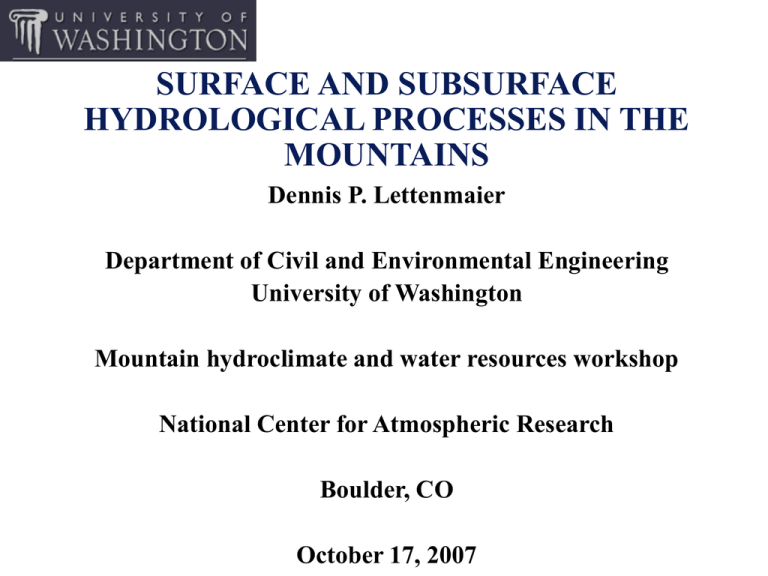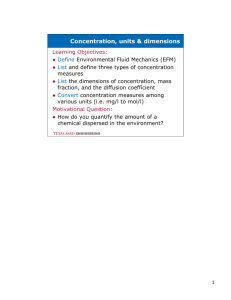No Slide Title - University of Washington
advertisement

SURFACE AND SUBSURFACE HYDROLOGICAL PROCESSES IN THE MOUNTAINS Dennis P. Lettenmaier Department of Civil and Environmental Engineering University of Washington Mountain hydroclimate and water resources workshop National Center for Atmospheric Research Boulder, CO October 17, 2007 Processes and variables considered • Surface Characteristics – Topography – Soils – Vegetation • Surface meteorological drivers – – – – Precipitation Temperature Solar Radiation Wind • Land surface hydrological processes – – – – Snow Subsurface hydrology Runoff generation Evapotranspiration • Hydrologic observations in mountain environments • Implications at the large scale – Colorado River climate sensitivity 1. Surface Characteristics Where are the mountains? Topography and vegetation, Puget Sound drainage basin, Washington Reynolds Creek Experimental Watershed vegetation, from field observations (left) and classified imagery (right) from Seyfried et al, WRR 2001 Topography and soil depth, Upper Billabong Creek Catchment, NWS, Australia visual courtesy CSIRO 2. Surface meteorological drivers PRISM annual precipitation climatology, western U.S. (visual from NOAA/NWS) PRISM monthly maximum temperature map, Sep, 2007 Source: www.prism.orgegonstate.edu Annual mean beam radiation (MJ/m2/day, Mt. Jumbong region, Korea from Kang et al, Can. J. For. Res., 2002 Downward solar radiation as a function of spatial averaging scale, Green Lakes Basin, Niwot Ridge, CO (2 PM, Apr 1) Visual courtesy Danny Marks Wind and snow accumulation factor, Reynolds Mountain East, for wind direction 230 degrees from Winstral and Marks, HP, 2002 3. Land surface hydrological processes Snow processes in a forest environment Partial snow coverage – Reynolds Creek Experimental Watershed (photo courtesy Danny Marks) Niwot Ridge Weather Station Visual courtesy John Pomeroy Visual courtesy John Pomeroy Visual courtesy John Pomeroy Visual courtesy John Pomeroy Energy balance over mountain snowpack, San Juan Mountains, CO, Spring 2005 from Bales et al, WRR, 2006 visual courtesy Danny Marks Runoff generation – the saturation excess mechanism Saturated area (source: Dunne and Leopold) Expansion of saturated area during a storm (source: Dunne and Leopold) Simulated depth to water table, Green River basin, Washington, Jan – July, 1996 Saturation excess isn’t always the mechanism! The importance of seasonal changes in surface energy fluxes -Distributed model spatial average (ADM) latent heat flux,, as compared with macroscale equivalent model (MSE) ADM MSE - ADM From Arola and Lettenmaier, J Clim, 1996 4. Hydrologic observations in mountain environments RCEW Ridge Site (visual courtesy Danny Marks) RCEW Grove Site (visual courtesy Danny Marks) Snow Water Equivalent (SWE) measurement – old and new Mt. Bigelow flux tower, AZ Stream gauge, Lower Stringer Creek, MT Concluding comments – why small scale hydrologic processes matter at the large scale Colorado River basin climate sensitivities as a case study: Why don’t GCM projections match those of hydrologic models? 20 02 20 06 20 10 20 14 20 18 20 22 20 26 20 30 20 34 20 38 20 42 20 46 20 50 20 54 20 58 20 62 20 66 20 70 20 74 20 78 20 82 20 86 20 90 20 94 20 98 RUNOFF(mm/yr) P-E (from Seager et al 2007) A2_EMISSIONS SCENARIO 140 120 Co River discharge (from C&L, 2007) 100 80 60 40 20 0 Visual courtesy Danny Marks Visual courtesy John Pomeroy



